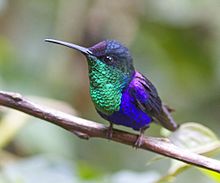Crowned woodnymph
| Crowned woodnymph | |
|---|---|

| |
| Male | |

| |
| Female | |
| Scientific classification | |
| Kingdom: | Animalia |
| Phylum: | Chordata |
| Class: | Aves |
| Order: | Apodiformes |
| Family: | Trochilidae |
| Genus: | Thalurania |
| Species: | T. colombica
|
| Binomial name | |
| Thalurania colombica (Bourcier, 1843)
| |
The crowned woodnymph (Thalurania colombica) is a species of bird in the hummingbird family Trochilidae. It is found in Belize and Guatemala to northern Peru. Its natural habitats are subtropical or tropical moist lowland forest, subtropical or tropical moist montane forest, and heavily degraded former forest.
Taxonomy[]
The crowned woodnymph was formally described in 1843 by the French ornithologist Jules Bourcier from a specimen collected in Columbia. He coined the binomial name Ornismya colombica.[2] This species is now placed in the genus Thalurania that was introduced by John Gould in 1848.[3]
Seven subspecies are recognised:[3]
- T. c. townsendi Ridgway, 1888 – Guatemala, Belize and Honduras
- T. c. venusta (Gould, 1851) – Nicaragua to Panama
- T. c. colombica (Bourcier, 1843) – north Colombia and northwest Venezuela
- T. c. rostrifera Phelps & Phelps Jr, 1956 – northwest Venezuela
- T. c. fannyae (Delattre & Bourcier, 1846) – Green-crowned woodnymph – east Panama to west Colombia
- T. c. subtropicalis Griscom, 1932 – Cauca Valley and nearby Andes (west-central Colombia)
- T. c. verticeps (Gould, 1851) – southwest Colombia and northwest Ecuador
- T. c. hypochlora Gould, 1871 – Emerald-bellied woodnymph – west Ecuador and northwest Peru
The green-crowned woodnymph T. c. fannyae was at one time treated as a separate species.[4] The Mexican woodnymph was formerly considered as a subspecies.
Description[]
The adult crowned woodnymph is 10.2 cm long and weighs 4.5 g. It has a violet crown, upper back, shoulders and belly, a shiny green throat and breast, green lower back, and a deeply forked blue-black tail. The female is 8.4–9 cm long and weighs 3.5 g. She is bright green above and duller green below, with a grey throat and breast. Her tail is rounded, mainly green near the body but with a blue-black lower half and white corners. Young males lack any violet or iridescence and are bronze-coloured below. Immature females have buff fringes on the feathers of the nape, face and rump. The call is a high-pitched fast kip.
Distribution and habitat[]
The crowned woodnymph is a common to abundant bird of wet lowlands and foothills to 2500 m, and may move higher when not breeding.
Behaviour[]
The female is entirely responsible for nest building and incubation. The clutch is two white eggs in a plant-fibre cup nest 1–5 m high on a horizontal branch. Incubation takes 15–19 days, and fledging another 20–26 days.
The food of this species is nectar, taken from a variety of flowers. Males feed in the canopy, where their food plants include epiphytic Ericaceae and bromeliads, and defend flowers and scrubs in their feeding territories. Females stay in the understory. After breeding, both sexes may concentrate at Heliconias. Like other hummingbirds, crowned woodnymph also takes small insects and spiders as an essential source of protein.[5]
Studies have shown territorial differences between males and females. Female crowned woodnymph territories are of higher quality compared to the males. This is because females are more aggressive in defending their territory. Female territories also received more intruders contrary to males and produced higher mean nectar volume. These factors point to the fact that female crowned woodnymphs have higher quality feeding territories than males.[6]
References[]
- ^ BirdLife International (2016). "Thalurania colombica". The IUCN Red List of Threatened Species. IUCN. 2016: e.T22726696A94929738. doi:10.2305/IUCN.UK.2016-3.RLTS.T22726696A94929738.en. Retrieved 14 January 2018.
- ^ Bourcier, Jules (1843). "Description de deux nouvelles espèce d'oiseaux-mouches de Colombie". Revue Zoologique (in French). 6: 2.
- ^ Jump up to: a b Gill, Frank; Donsker, David; Rasmussen, Pamela, eds. (July 2020). "Hummingbirds". IOC World Bird List Version 10.2. International Ornithologists' Union. Retrieved 15 January 2020.
- ^ Donegan, Thomas (October 2012). "Proposal 558: Treat Thalurania fannyi and Thalurania colombica as conspecific". South American Classification Committee, American Ornithologist Society. Retrieved 15 January 2021.
- ^ Stiles, F. Gary; Skutch, Alexander F. (1989). A Guide to the Birds of Costa Rica. Ithaca, NY: Cornell University. pp. 217–218. ISBN 978-0-8014-9600-4.
- ^ Bertin, Robert I.; Wilzbach, Peggy A. (1979). "Sexual differences in feeding territoriality of the crowned woodnymph, Thalurania colombica" (PDF). Wilson Bulletin. 91 (2): 319–321.
- IUCN Red List least concern species
- Birds described in 1843
- Hummingbird stubs
